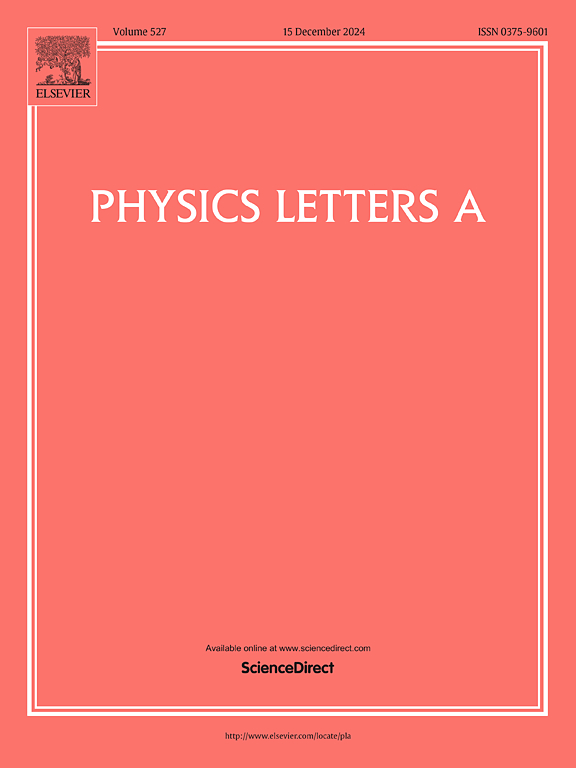Theoretical investigations on structural evolution, photoelectron spectroscopy and electronic properties of precious metal silver doped boron clusters
IF 2.3
3区 物理与天体物理
Q2 PHYSICS, MULTIDISCIPLINARY
引用次数: 0
Abstract
The growth mechanism of borophene on silver substrates is fundamentally linked to silver-boron bonding interactions, yet the structural evolution and bonding characteristics of Ag-B clusters remain poorly understood. Here, we present a theoretical study into a range of silver-doped boron clusters using the CALYPSO cluster structural prediction method combined with density-functional theory (DFT) calculations. Global minimum searches reveal that the most AgB clusters possess planar or quasi-planar structures with the Ag atom clinging to the edge of the Bn moiety. Based on these ground-state structures, we successfully simulated the photoelectron spectroscopy of silver-boron clusters. The aromatic AgB cluster with a quasi-planar configuration (1A, ) is found to exhibit the largest vertical detachment energy in the photoelectron spectra and show excellent stability. Further bonding analysis reveals that the most stable quasi-planar aromatic structure is formed by the significant interactions (3c-2e σ-bonds) between Ag and the main boron cluster, which are contributed by the Ag-5s and B-2p atomic orbitals, as well as by the presence of B-B σ-bonds within the main boron cluster. These results quantitatively establish the synergy between dative charge transfer and multicenter bonding in Ag-B systems, providing atomistic insights into borophene nucleation processes on silver surfaces. The identified structural motifs and bonding patterns lay a theoretical foundation for designing boron-based nanomaterials with tailored metal-doping configurations.
贵金属银掺杂硼团簇结构演化、光电子能谱及电子性能的理论研究
硼罗芬在银基底上的生长机制与银-硼键相互作用有关,但Ag-B簇的结构演变和键合特征仍知之甚少。本文采用CALYPSO簇结构预测方法结合密度泛函理论(DFT)计算,对一系列掺银硼簇进行了理论研究。全局最小搜索表明,大多数AgBn -簇具有平面或准平面结构,Ag原子附着在Bn部分的边缘。基于这些基态结构,我们成功地模拟了银硼团簇的光电子能谱。具有准平面构型(1A, C1)的芳香族AgB18−簇在光电子能谱中表现出最大的垂直脱离能,并具有优异的稳定性。进一步的成键分析表明,Ag与主硼团簇之间存在显著的相互作用(3c-2e σ-键),其中Ag-5s和B-2p原子轨道以及主硼团簇内存在B-B σ-键,形成了最稳定的准平面芳香结构。这些结果定量地确定了Ag-B体系中负电荷转移和多中心成键之间的协同作用,为银表面硼罗芬成核过程提供了原子层面的见解。确定的结构基序和键模式为设计具有定制金属掺杂构型的硼基纳米材料奠定了理论基础。
本文章由计算机程序翻译,如有差异,请以英文原文为准。
求助全文
约1分钟内获得全文
求助全文
来源期刊

Physics Letters A
物理-物理:综合
CiteScore
5.10
自引率
3.80%
发文量
493
审稿时长
30 days
期刊介绍:
Physics Letters A offers an exciting publication outlet for novel and frontier physics. It encourages the submission of new research on: condensed matter physics, theoretical physics, nonlinear science, statistical physics, mathematical and computational physics, general and cross-disciplinary physics (including foundations), atomic, molecular and cluster physics, plasma and fluid physics, optical physics, biological physics and nanoscience. No articles on High Energy and Nuclear Physics are published in Physics Letters A. The journal''s high standard and wide dissemination ensures a broad readership amongst the physics community. Rapid publication times and flexible length restrictions give Physics Letters A the edge over other journals in the field.
 求助内容:
求助内容: 应助结果提醒方式:
应助结果提醒方式:


